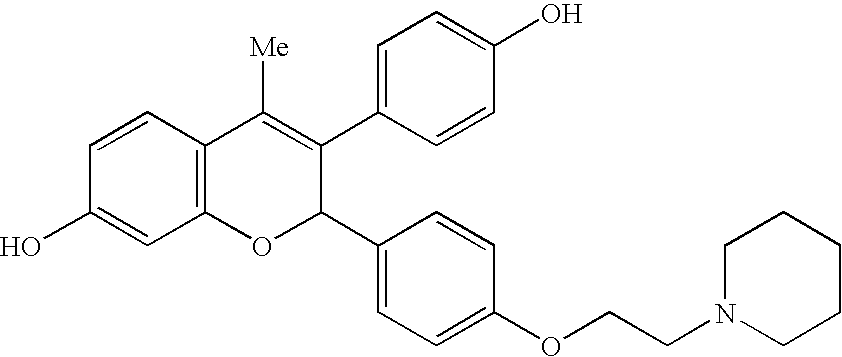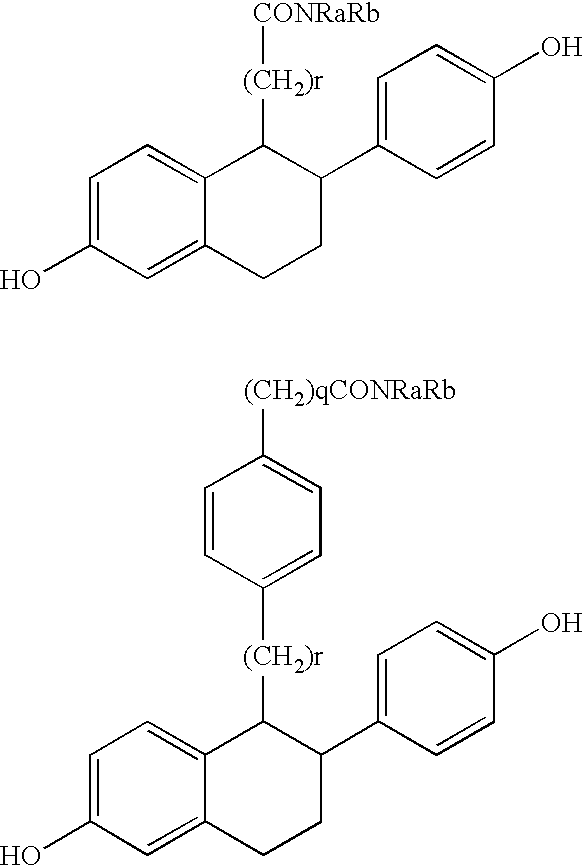Compounds with hydroxycarbonyl-halogenoalkyl side chains
a technology of hydroxycarbonyl halogenoalkyl and side chains, which is applied in the direction of antineoplastic agents, steroids, organic chemistry, etc., can solve the problems of reducing the therapeutic effect of oral administration, unable to inhibit the effect induced through the estrogen receptor, and unable to achieve the effect of blocking estrogen production, so as to improve the stability of oral activity, improve the effect of absorption from the intestinal tract and increase oral activity
- Summary
- Abstract
- Description
- Claims
- Application Information
AI Technical Summary
Benefits of technology
Problems solved by technology
Method used
Image
Examples
example 1
Synthesis of 6-methoxy-2-(4-methoxyphenyl)-1-(2-propenyl)-naphthalene
[0200]
[0201] 6-Methoxy-2-naphthol (22.1 g, 127.0 mmol) was dissolved in acetone (200 ml). Potassium carbonate (70.2 g, 508.0 mmol) and allyl bromide (16.5 ml, 191.0 mmol) were added to the resulting solution followed by stirring for 2 days at room temperature. After the reaction mixture was filtered, the organic solvent was distilled off under reduced pressure. Water was added to the residue, which was then extracted with ethyl acetate. The organic layer was washed with saturated aqueous sodium chloride and dried over anhydrous sodium sulfate. The organic solvent was distilled off again to give 6-methoxy-2-(2-propenyloxy)naphthalene (24.9 g, Yield 91%) as a crude product.
[0202]1H-NMR(270 MHz, CDCl3): δ 7.66-7.60 (m, 2H, Ar—H), 7.18-7.10 (m, 4H, Ar—H), 6.20-6.05 (m, 1H, CH2═CHCH2—), 5.45 (dd, J=18.8, 1.3 Hz, 1H, CH2═CHCH2—), 5.31 (dd, J=10.5, 1.3 Hz, 1H, CH2═CHCH2—), 4.62 (d, J=5.3 Hz, 2H, CH2═CHCH2—), 3.90 (s, 3H...
example 2
Synthesis of diethyl 2-(5-hexenyl)-2-(4,4,5,5,5-pentafluoropentyl)malonate
[0209]
[0210] A solution of diethyl 2-(4,4,5,5,5-pentafluoropentyl)malonate (4.0 g, 12.5 mmol) in dimethyl sulfoxide (30 ml) was cooled to 10° C. To this solution, 60% sodium hydride (600 mg, 15 mmol) was added, and the resulting mixture was stirred for 1 hour at room temperature. 6-Bromo-1-hexene (2.5 ml, 18.75 mmol) was slowly added dropwise to the reaction mixture, followed by stirring for 3 hours at room temperature. Water was added to the reaction mixture, which was then extracted with ethyl acetate. The organic layer was washed with water and saturated aqueous sodium chloride, and then dried over anhydrous sodium sulfate. After distilling off the solvent, the residue was purified by silica gel column chromatography (eluent: ethyl acetate / hexane=1 / 9) to give diethyl 2-(5-hexenyl)-2-(4,4,5,5,5-pentafluoropentyl)malonate (3.86 g, Yield 77%).
[0211]1H-NMR(270 MHz, CDCl3): δ 5.82-5.72 (m, 1H, —CH═CH2), 5.02-4...
example 3
Synthesis of 9-[6-hydroxy-2-(4-hydroxyphenyl)naphth-1-yl]-2-(4,4,5,5,5-pentafluoropentyl)nonanoic acid
[0212]
[0213] The diethyl 2-(5-hexenyl)-2-(4,4,5,5,5-pentafluoropentyl)-malonate prepared in Example 2 (1.83 g, 4.55 mmol) and benzylidene-bis(tricyclohexylphosphine)dichlororuthenium (94 mg, 0.11 mmol) were added to a solution of 6-methoxy-2-(4-methoxyphenyl)-1-(2-propenyl)naphthalene (692 mg, 2.28 mmol) in dichloromethane (10 ml), followed by heating under reflux for 20 hours under argon atmosphere. After distilling off the solvent, the residue was purified by silica gel flash column chromatography (eluent: hexane / ethyl acetate=10 / 1) to give the desired olefin (1.8 g) as a mixture of cis- and trans-forms and side chain dimer. This mixture was dissolved in ethyl acetate (20 ml), and 10% palladium carbon (236 mg) was added to the resulting solution followed by stirring for 2 hours at room temperature under hydrogen atmosphere. The catalyst was removed by filtration and the solvent w...
PUM
| Property | Measurement | Unit |
|---|---|---|
| Dimensionless property | aaaaa | aaaaa |
| Inhibition | aaaaa | aaaaa |
| Inhibition | aaaaa | aaaaa |
Abstract
Description
Claims
Application Information
 Login to View More
Login to View More - R&D
- Intellectual Property
- Life Sciences
- Materials
- Tech Scout
- Unparalleled Data Quality
- Higher Quality Content
- 60% Fewer Hallucinations
Browse by: Latest US Patents, China's latest patents, Technical Efficacy Thesaurus, Application Domain, Technology Topic, Popular Technical Reports.
© 2025 PatSnap. All rights reserved.Legal|Privacy policy|Modern Slavery Act Transparency Statement|Sitemap|About US| Contact US: help@patsnap.com



